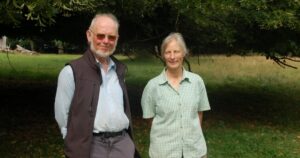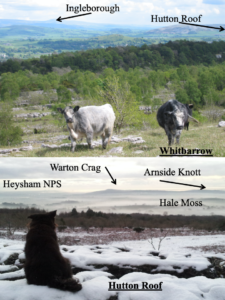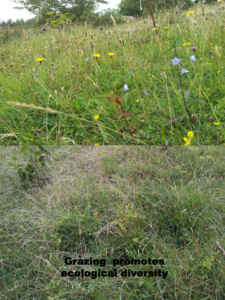Pasture Champions: Bill and Cath Grayson Morecambe Bay Conservation Grazing Company 1/5
 Bill and Cath Grayson
Bill and Cath Grayson
Tell us about your farm – location, size, altitude, climate, soils, enterprises, organic/PfL/other status?
My wife, Cath and I farm about 650 ha of different semi-natural habitats, which include unimproved rough grazing (mostly on limestone), meadow, heath, salt marsh, fen, reed bed, wood pasture and scrub, all of them located within the area adjoining Morecambe Bay in north west England which is North Lancashire and South Cumbria. We're known as the Morecambe Bay Conservation Grazing Company or MBCGC.
Our system, which has been continuously evolving over the last 30 years, is a rather unconventional one, in that it consists of a suite of separately leased land parcels, none of which amounts to a viable farm unit in their own right. However, in combination, they provide a basis for a successful Organic- and Pasture for Life-certified livestock operation, based on Red Poll cattle and Easycare sheep.
The entire land holding, in its current form, extends from the edge of the Bay up to 150m on the surrounding limestone hills and, although most of the land would be deemed rough grazing, the system has proved itself capable of breeding and growing healthy, well finished cattle and sheep, albeit not in the numbers or the speed that are typical of more favourably situated farms.
 Whitbarrow and Hutton Roof
Whitbarrow and Hutton Roof
The climate is typically mild and wet, with more than 1000 mm of rainfall falling in most years on most of the sites we graze. Summers are much less predictable and over the last 10 years have been marked by longer bouts of hot dry weather, usually in the first half of the season when the impact on plant growth can be most damaging.
The wide range of vegetation types found around Morecambe Bay is associated with the wide variations in soil type, which includes everything from deep peats to shallow, stony soils on limestone outcrops, the two sometimes occurring just a few meters apart.
It is surprising, looking at the lush scenery we see here today, to think that ice had stripped much of the soil from this glaciated landscape only some ten thousand years ago. This dramatic recovery of the landscapes demonstrates the power of Nature’s regenerative potential long before our industrialized system of land-use began to dominate our countryside.
Share with us a general description of the biodiversity on your farm – essentially above ground, but reference to below ground if relevant, both flora and fauna.
The wide variety of different sites and habitats included within our farming system makes it difficult to succinctly describe the full extent of its biodiversity interest.
All of the sites within our system are managed primarily for their nature conservation interest, with most having been formally designated because of their importance for wildlife, either as National Nature Reserve (NNR); Site of Special Scientific Interest (SSSI) or Local Nature Reserve (LNR). Even the sites that don’t enjoy any official designation are still being managed for their wildlife value under one of DEFRA’s agri-environment schemes.
Grazing livestock play a crucial role in the management of all of these sites, in delivering the specific conservation objectives for each of the different types of habitat, hence the term ‘conservation grazing’.
The animals’ grazing and browsing activities modify the structure and species composition of the vegetation, their trampling breaks up dense stands of resistant plant material, and creates patches of bare ground where plant seeds can germinate and insects can lay eggs or absorb heat from the sun, whilst the dung they produce provides food for huge numbers of different invertebrates, so that it becomes an essential source of nutrients for future plant growth.
Conservation grazing involves constantly monitoring of all these different activities so that the numbers and types of grazing animals and the timing and duration of the grazing season can be adjusted to achieve the best outcomes for Nature.
 Ecological diversity
Ecological diversity



